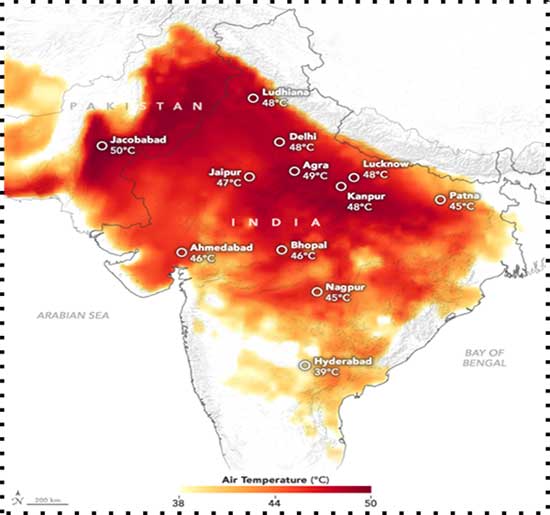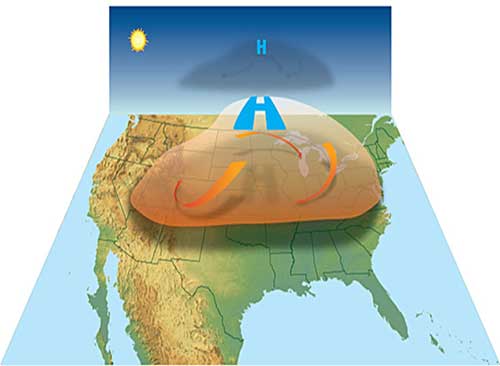Date : 16/06/2023
Relevance: GS3: Climate Change
Key Words: Climate Change,Heat Waves, IMD action Plan, Vulnerable section of society, Anti cyclonic high pressure system, Heat Dome.
Context-
- Recently fourteen people lost their lives to heatstroke, during an official government ceremony held on open ground in Kharghar in Navi Mumbai, Maharashtra. Several hundred were hospitalised.This was a tragedy that could have been averted with the right precautions in place.
- Temperatures have been steadily rising in India. February 2023 was the hottest February on record in the country. Although monthly average temperatures during March and April were above normal, they were not exceptionally high due to scattered thunderstorms bringing down the mercury. Daily maximum temperatures, however, went 2-3 degrees above normal on several days, even while not being classic heatwaves.
- Climate projections indicating a sixfold increase in heat waves by 2060, such plans are needed immediately to protect vulnerable communities.
What are Heat Waves?
- The IPCC defines heat wave as "a period of abnormally hot weather, often defined with reference to a relative temperature threshold, lasting from two days to months.
How do heat waves occur?
- Heat Waves occur when dry and hot air sinks from the upper atmosphere and pushes down towards the surface of the earth. As it descends, the air gets compressed and becomes even hotter, creating a stifling dome of heat. This makes it hard for clouds to form, which means that the sun’s heat can directly reach the ground, making the region even hotter. This is why heat waves often occur on clear, sunny days.
What is Heat Dome?
- A heat dome is caused when the atmosphere traps hot ocean air, as if bounded by a lid or cap. The upper air weather patterns are slow to move, referred to by meteorologists as an Omega block.
Heat Dome formed in USA
- This is a typical condition in the Indian subcontinent during April-May. Now we have additional heat accumulating due to climate change, resulting in more intense heat waves.

Heatwave Zones and Vulnerable Populations:
- The arid northwest Indo-Pakistan region, which is home to about 760 million people, is particularly vulnerable to record-breaking heatwaves. During April-May, temperatures frequently exceed 40°C, sometimes leading to scorching heat waves. These events have become more intense, longer lasting, and more widespread in recent years.
- Geographically, the heatwave zone lies diagonally across the Indo-Pak region. In India, the States of Punjab, Himachal Pradesh, Uttarakhand, Delhi, Haryana, Rajasthan, Uttar Pradesh, Gujarat, Madhya Pradesh, Maharashtra, Chhattisgarh, Bihar, Jharkhand, West Bengal, Odisha, Andhra Pradesh, and Telangana lie in the heatwave zone. Between 1971 and 2019, heatwaves claimed about 17,362 lives in India that is about 350 lives a year on an average.

Impact of Climate Change
- The intensification of heat extremes is a direct consequence of the 1-degree Celsius rise in global mean temperatures resulting from historical carbon emissions. Regrettably, current commitments from global nations are insufficient to prevent a temperature rise of 1.5°C between 2020 and 2040 and 2°C between 2040 and 2060.
- The region’s largely vulnerable population is expected to reach 1 billion by 2050, further raising concerns about the impact of future heat waves..
- The looming prospect of a doubling of global temperatures in the coming decades demands immediate attention, as the impacts of such a rise are difficult to fathom.
Heatwaves, Dryness, Fires, and Pollution:
- Record-breaking heat waves in 2022, with temperatures surpassing 50°C in India and 51°C in Pakistan, lasted from March to May. The absence of thunderstorms during this period compounded the impact, leading to widespread fires, crop loss, and water scarcity.
- These extreme conditions affected wheat production, necessitating a reduction in wheat exports to ensure national food security.
- Additionally, stagnant atmospheric conditions contributed to elevated pollution levels, as particles from fires and stubble burning remained in the air.
The Urgent Need for Action:
- The India Meteorological Department (IMD) provides heatwave warnings on a six-hourly basis, for the next five days. These forecasts go to all cities and districts of India, where the local governments prepare a yellow (watch), orange (be prepared) or red (take action) alert based on the severity of the heatwave. There are heatwave outlooks for the next two weeks and for the season, that can help in advance planning.
- After the fatal heat waves in 2010, the Ahmedabad Municipal Corporation developed a Heat Action Plan for the city in coordination with the meteorological forecasts. The community outreach, health alerts, training of healthcare professionals, and efforts specifically targeted at vulnerable groups have helped reduce the impacts of heat stress on the local population. Drawing lessons from Ahmedabad’s Heat Action Plan, several cities and States have initiated their own action plans with the help of disaster management agencies and health departments..
- We need policies considering the fact that heatwaves are here to stay and intensify. We have sufficient data to identify the regions where the heatwaves are increasing and we need to have policies in all those places. We need to redesign our cities to have open spaces and trees that help release the excess heat quickly and also act as hubs for shade and cooling down.
- Integrating a heat emergency plan into the education system and workplace policies can equip individuals to handle heat emergencies and protect their health and well-being.
- India needs a long-term vision where we have policies that help us in managing our work hours, public infrastructure, schools, hospitals, workplaces, houses, transportation, and agriculture for heat waves to come.
Conclusion
The India Meteorological Department (IMD) provides heatwave warnings on a regular basis, allowing local governments to issue appropriate alerts based on severity. However, relying solely on forecasts is insufficient. Comprehensive heat action plans, based on long-term vision, must be implemented.
Probable Questions for Mains exam-
- Question 2: What is Heat waves? How climate change is responsible for increasing the intensity of Heat waves in recent times? (10 Marks, 150 Words)
- Question 1: What measures has the Indian government taken to address the increasing threat of heatwaves and protect vulnerable communities? Discuss the importance of comprehensive heat action plans and the need for a long-term vision to manage various sectors in light of rising temperatures. (15 Marks, 250 Words)
Source: The Hindu








